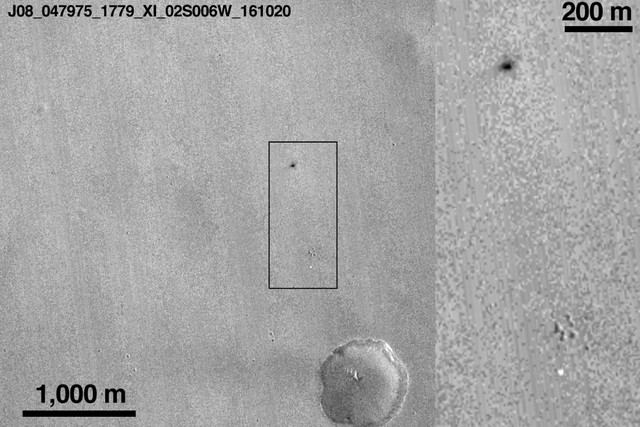NASA Images Suggest the ExoMars Lander Exploded During Landing

Bummer! Big bummer for the European Space Agency. Images provided by NASA suggest that the ExoMars lander exploded as it attempted to land on the Red Planet.
The European Space Agency had high hopes for its ExoMars lander. The Schiaparelli module successfully detached from the Trace Gas Orbiter (TGO) that helped guide the spacecraft to the outer edge of Mars’ atmosphere. Once it was on its own, the lander began its descent to the Martian surface. Everything was going to plan until the final minutes when the ESA lost contact with the vessel. Its fate is still unknown, but recent images of the Mars surface that were taken by NASA suggest the lander exploded upon impact.
In the days after the ExoMars experienced its unfortunate landing, NASA has been collecting and analyzing surface photos taken by the Mars Reconnaissance Orbiter using the vessel’s low-resolution CTX camera. NASA worked with the ESA to record the descent of the lander as part of the planned mission. The images are believed to show the entry, the descent via parachute and the subsequent landing of the spacecraft. The final images show a broad, dark patch, approximately 50 x 130 feet in dimensions, that is thought to show the impact and possible destruction of the Schiaparelli module on landing.
Exactly what happened to the Schiaparelli lander is not yet known. ESA scientists hypothesize the module crashed when its thrusters were turned off prematurely. Instead of floating to a soft landing using thrusters, the lander dropped up to 2.5 miles at a speed of 184 mph. If the thrusters were not operational, then the module would have crash landed with a full load of fuel. The fuel would have exploded on impact, producing the large cloud of surface debris that was seen on the MRO footage.
The ExoMars team is still collecting and analyzing the mission data to figure out what happened to the spacecraft during its descent. The ESA will be analyzing imagery taken by its orbiting TGO and will review the high-resolution images taken by the MRO’s HiRISE camera. These high resolution images should provide more details about the descent of the vessel than the low resolution images already analyzed. Hopefully, the ESA can learn what happened to its lander so it can make adjustments before its planned Mars Rover landing in 2020.



